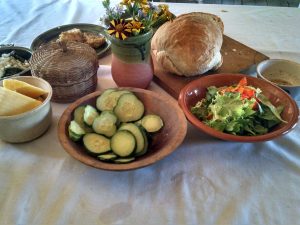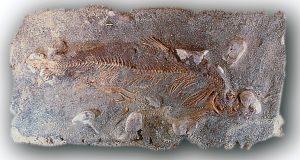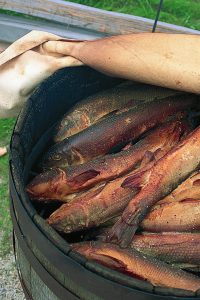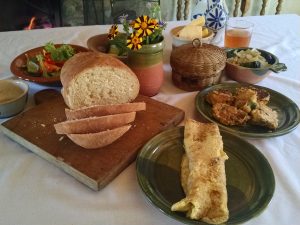
Hunters across the state will take to the woods for opening day of Michigan’s firearm deer season today. Some will bring home the big buck and venison to add variety to mealtimes. It’s easy to imagine the 18th century French Canadian residents of Michilimackinac doing much the same thing, relying upon hunting and fishing to load their tables with a wealth of wild game. However, like many so many other things, Michilimackinac’s historic food culture is considerably more complex.
Prior to 1730, all French residents of Michilimackinac had similar access to the same types of food, which remained heavily focused on domestic items such as pork and beef. Wealthier individuals had slightly better access to a wider variety of fruits and nuts, as well as better cuts of domestic meat. This accessibility only improved over time, as trade routes matured and Michilimackinac grew into a hub of the Great Lakes fur trade. Despite what visiting military engineer Michel Chartier Lotbiniere reported in 1749, the French at Michilimackinac were not dependent upon local foods, and indeed continued to import domestic animals and meats throughout their period of control.

However, the French did indeed adapt their cuisine to include some local foods. In House C of the Southwest Rowhouse (the Solomon-Levy House), for example, over 50% of the faunal remains recovered archaeologically from the French-era deposit came from wild sources, while 20% came from domestic animals. The remainder were unidentified. In House D, meanwhile, 57% of the total biomass from the French era came from wild sources, while only 18% came from domestic sources. The remainder were unidentifiable. At face value, it appears that the French residents of these households were consuming more wild game than domestic foods, and indeed they were, but it is important to note which types of wild foods were being consumed. In House D, a more detailed breakdown of the recovered biomass reveals that 45% of the remains came from fish, followed by unidentified mammal (20%), domestic mammal (18%), wild mammal (9%), unidentified bird (4%), and domestic bird (3%). Clearly, the most common meat being consumed in the house was fish, followed relatively closely by domestic mammals such as cows and pigs. Remains from both houses revealed a preference for whitefish and passenger pigeons, as these species were the most common wild fish and birds represented in the faunal assemblage.
Why were whitefish and passenger pigeons so frequently consumed, rather than larger wild animals like deer? Perhaps the most basic reason was that they were relatively easy to procure and tasted good. Observers in the 18th century noted the ease with which hunters could kill large numbers of passenger pigeons (there’s a reason they’re extinct…). Passenger pigeons were so popular that Quebec butchers complained that domestic meat sales drastically declined during the birds’ spring migration. Furthermore, a preference for pigeons may have reflected resistance to cultural and legal traditions in metropolitan France, where access to game was highly regulated and largely confined to the wealthy. When French colonists reached the interior of North America, they were confronted with an environment brimming with wild game free for the taking, regardless of class or economic standing.

Fish, on the other hand, were often the only readily available source of meat through the long winter months at Michilimackinac. In addition to being naturally abundant in the Straits of Mackinac, fish were a welcome addition to the diets of the Canadians, who, being overwhelmingly Catholic, followed a strict liturgical calendar which dictated nearly 150 fast days when no meat was to be consumed. Consumption of fish, however, was specially allowed by church law. Whitefish was especially popular at Michilimackinac, being one of the most common species in the Straits of Mackinac.
Despite these examples, it is important to note that whenever their finances and the logistics of the shipping season allowed, French residents at Michilimackinac and elsewhere in Canada preferred domestic foods. In other words, if they could afford it and obtain it, the French at Michilimackinac preferred to continue eating the same sorts of pork and beef dishes as their continental counterparts. Poorer French residents also preferred domestic meats, albeit in cheaper cuts and often in salted or dried form, a phenomenon observed by Swedish botanist Peter Kalm during his travels through Canada in the late 1740s.

The wild game that was consumed at Michilimackinac, especially in the form of fish and passenger pigeons, represented concessions to local conditions, namely, the geographical isolation of the community, personal preference for select wild game meats that tasted good, and the ease and relatively low cost of procuring certain wild food. While it’s tempting to imagine a French Canadian merchant hauling a deer home to feed his family at Michilimackinac, it’s much more likely that his table was loaded with whitefish and passenger pigeons.









